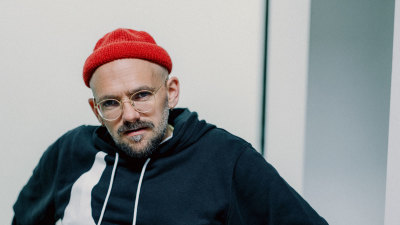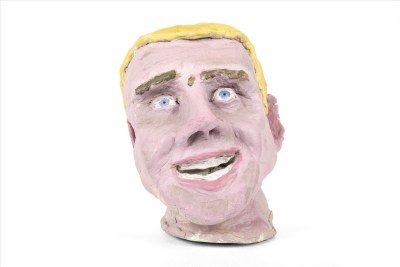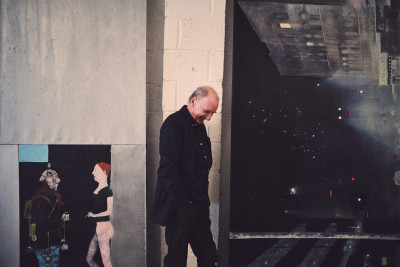10 minutes with… Conrad Shawcross RA Elect
10 minutes with… Conrad Shawcross RA Elect
By Tom Jeffreys
Published 10 March 2014
Each month, we have a quick chat with one of our Academicians to find out what they’re up to and what the RA means to them.
-
Attracted by failed quests for knowledge from the past, Conrad Shawcross RA often appropriates redundant theories and methodologies to create large-scale mechanical contraptions and strange robotic devices. In the last few years, Shawcross has had solo shows at the Roundhouse, National Gallery, and Science Museum here in London, as well as numerous exhibitions across the world. He was elected Royal Academician in 2013.
-
What are you working on at the moment?
I’m always working on a few things at once. We’re doing a series of three large cast iron loops to replace the stolen Hepworth in Dulwich Park. Each one is a mathematical representation of a musical chord. It’s supposed to be the opposite of traditional civic sculpture, so it’s meant to be sat on, climbed over, and interacted with. We’re hoping to install that in late summer.
There’s also the ongoing Ada Project, inspired by Ada Lovelace, where we invite selected musicians for a residency to work with a collographic robot that we’ve created. The artist responds to the existing machine and its choreography. They have to compose a piece of music to fit the machine, rather than the other way around. Later this year we’ll be setting up a temporary space in Soho, where we will install it. We’ll also be releasing the records and hosting a curated programme of events there.
We’re working on a range of other projects too, as well as doing a major renovation of the studio. Hopefully it’ll be completed for October this year.
What is your earliest memory of art?
My step-father is a painter, and he taught me to draw and paint when I was little. I remember going to his studio and loving the smell of it and the whole mood. My mother’s writing study didn’t quite have the same visual response.
Then when I was 12 or 13 there was a Bill Viola show at the Whitechapel. I went back about four times – it was a real turning point for me. I was captivated, especially by the Nantes Triptych, which depicts his wife giving birth and his mother dying. If anything, it was that work which made me want to be an artist.
-
To be a good Academician I just need to carry on making good art.
Conrad Shawcross RA
-
What work of art do you most wish you’d made?
I’m jealous of the time that painters get to spend engaged with their material and their craft. I don’t have an intuitive understanding of painting but I’m jealous of that escape into the task of applying paint to surface. I’m increasingly away from the grindstone these days – directing and delegating. I’m not a master anymore. The closest I came to that was the carpentry I used to do for my old works. I miss being on my own, just making things and dreaming.
How do you know when a work is finished?
That is much easier for me than for other artists, especially painters. There’s so much engineering and pre-thought, it’s almost an architectural approach. It’s not really intuitive or arbitrary, like, say, Anthony Caro – he had an amazing instinct. I’m really scared of the arbitrary; I want to be rigorous and rule-based. How do you know when it’s over? With painting it’s so perilous, whereas sculpture you can go backwards. With my work, we plan each one out rigorously from the beginning. They’re about function: if they work, if they perform and run smoothly, then they’re finished.
Do you have a photo of yourself on your phone you can send us?
-
Where were you when you found out you had been elected as an Academician?
I was in Venice when I got the call from Tracey Emin. I also proposed to my wife later in the evening, so it was quite a day. I was planning to propose anyway, but it certainly put some extra lead in my pencil!
What does the RA mean to you?
Becoming an RA felt like such an incredible endorsement. But there’s a danger when you receive this kind of acclaim that it can make you feel that you’ve arrived, which is exactly what threatens creativity. You have to keep working hard. To be a good Academician I just need to carry on making good art.
If you were President of the RA for a day, what would you change?
If the RA has a problem, and this may sound perverse, it’s that it has such an incredible setting. But it’s problematic because it can be associated with elitism and the old guard – especially in the last century, with some of its attitudes towards contemporary art. I would like to see the RA have outposts away from Mayfair, in places like Sheffield and Margate: little pods created by contemporary architects that take, say, a work by Reynolds, to people who would never come here. These pavilions would be about taking art to new places, decontextualising it, and using the RA’s creativity as a force for education.
Which Academician would you like us to interview next, and what should we ask them?
You should speak to Mike Nelson. He’s a great artist.
Find out more about Conrad Shawcross RA Elect.




